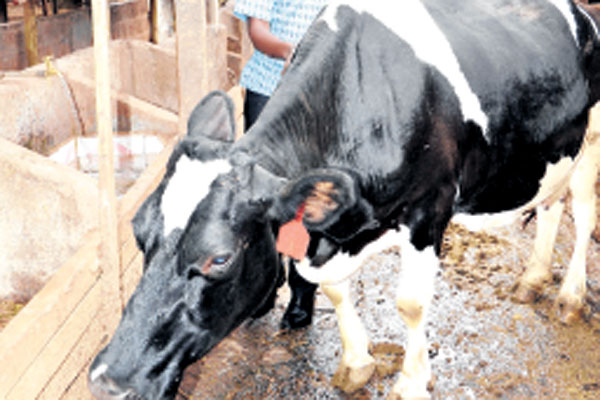Dairy Business Kenya: Mwangi Waithuki’s home in Githunguri, Kiambu County, also doubles up as his dairy farm. It is so serene that it is difficult for a visitor to know that it hosts over 40 dairy cows.
Having been fed to their satisfaction mid-morning, we find the animals quiet, chewing the cud. Near the cowshed, two young men slice maize stalks and napier grass on chuff cutters, while two others ferry the feeds to them.
An hour earlier, the workers had milked the cows for the second time and delivered the produce to Githunguri Dairy, the maker of Fresha milk brands. “We are preparing feeds for the following day. We always ensure they are ready every day by 4pm,” says Francis Thuo, the farm manager.
Earlier, they had also mixed different dairy meal ingredients sourced from specific agrovets. Waithuki, one of the leading dairy farmers in the county, delivers 650 litres of milk a day to the processor from 40 cows that he milks. He attributes the huge quantity of milk to his feeding regime.
Waithuki uses maize germ, wheat pollard, wheat bran, sun flower, macadamia nuts, groundnuts, cottonseed cake, fish meal and dairy salt to make the feeds. Thuo trained in Animal Health and Production at Kabete Animal Health Industry Training Institute (Ahiti).
To prepare 1,000kg of dairy meal, he and his workers mix maize germ (260kg), wheat pollard (100kg), wheat bran (240kg), sunflower (50kg), macadamia (50kg), groundnuts (60kg), cotton seed (150kg), fish meal and dairy salt (10kg).
“The mixture ensures we have the best dairy meal which cannot be found in any livestock feed stores. We prepare in bulk once every day to enjoy economies of scale and to ensure the animal gets fresh meals.” Apart from the dairy meal, Waithuki, who has been in the business for over 20 years, further feeds the cows on silage, napier grass, ordinary green grass and hay.
“We make silage from maize we grow in Machakos which we harvest as soon as it develops the cobs. We then cut it into pieces, put in silos and mix with molasses,” Thuo explains. They source napier grass and green grass from farms in Kiambu while they buy hay in bulk from different suppliers.
“We slice the grasses into small pieces using the chuff cutters. Nine cows share three troughs of the grasses. Their daily portion comprises of three 75kg bags of fodder, silage, three 20 litre buckets of the dairy meal and 40 litres of yeast to help in digestion and milk production.”
Grace Wambere: How I made it in mitumba business after quitting IT job
“We feed them once at 2am on all the feeds and then during the day we offer them some dairy meal only. The early feeding helps them to completely digest the feeds to produce more milk. .”
The cows also have unfettered access to plenty of clean water. According to animal experts, the balanced diet is enough to take the cows for 24 hours. Feeding time, on the other hand, does not matter, as long as the animals get the right quantity of feeds for the day.
The farm, according to Thuo, spends between Sh1,300 and Sh1,400 to make a 70kg bag of dairy meal. In shops, the same bag costs Sh1,680. Before they adopted the new feeding system, Thuo says they used to get 400 litres of milk a day from the 40 cows.
Unlike in most farms where cows are milked twice a day, here they are milked three times. According to Thuo, they do the first milking at 3am, then between noon and 1.30pm and lastly at 6pm. During milking, the cows are offered some dairy meal.
“We get from each cow from 30 to 40 litres of milk a day during their peak due to the quality feeds but normally production of each is between 18 and 35 litres depending on the stage of lactation. Good feeds make animals offer more,” says Thuo. This means that with a minimum of 30 litres from every cow, Mwangi Withuki could rake in a gross income of Sh. 1.4 million per month from his dairy farm. However, from the 650 litres he submits, he makes a gross of around Sh.780,000 per month.
Each litre is sold to Githunguri Dairy at Sh40. Joseph Mureithi, the principal at Waruhiu Agricultural Development Centre in Githunguri, says processing own feeds is the only way to ensure quality feeds and cut costs. He advises farmers to form groups, buy raw materials and be trained on how to manufacture the feeds. Dairy Business Kenya. Dairy Business Kenya.









i got lots of maize stalks for silage. kindly let me know if interested or refer me to concern individuals